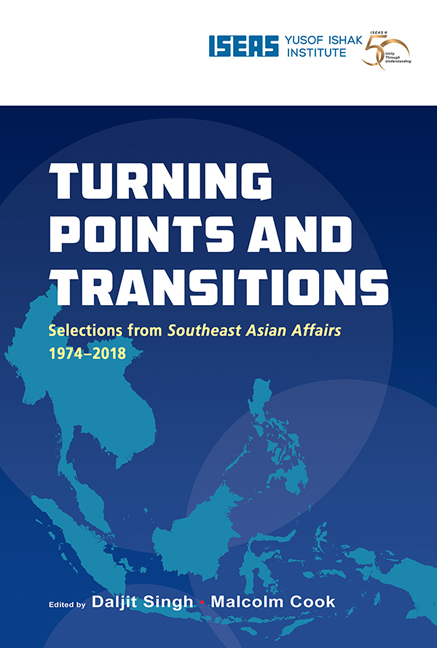Book contents
- Frontmatter
- Contents
- Message from the Director
- Foreword
- Foreword
- Introduction
- THE REGION
- The Diplomatic Emergence of China and Its Implications for Southeast Asia (1975*)
- Stability and Security in the Region after ANZUK (1975)
- The Question of the “Overseas Chinese” (1976)
- Southeast Asia 1976: The Handling of Contradictions (1977)
- The “Fukuda Doctrine” and Its Implications for Southeast Asia (1978)
- Expanding Horizons in Southeast Asia? (1994)
- AFTA in the Light of New Economic Developments (1995)
- The ASEAN Economic Miracle Unravels (1999)
- Southeast Asia in 1999: A False Dawn? (2000)
- East Timor's Future: Southeast Asian or South Pacific? (2001)
- Southeast Asia in 2002: From Bali to Iraq — Co-operating for Security (2003)
- The Year in ASEAN: The Charter, Trade Agreements, and the Global Economic Crisis (2010)
- Seeking Stability in Turbulent Times: Southeast Asia's New Normal? (2015)
- China's Two Silk Roads Initiative: What It Means for Southeast Asia (2015)
- China's International Strategy and Its Implications for Southeast Asia (2016)
- BRUNEI
- CAMBODIA
- INDONESIA
- LAOS
- MALAYSIA
- MYANMAR
- THE PHILIPPINES
- SINGAPORE
- THAILAND
- VIETNAM
The Diplomatic Emergence of China and Its Implications for Southeast Asia (1975*)
from THE REGION
Published online by Cambridge University Press: 29 May 2019
- Frontmatter
- Contents
- Message from the Director
- Foreword
- Foreword
- Introduction
- THE REGION
- The Diplomatic Emergence of China and Its Implications for Southeast Asia (1975*)
- Stability and Security in the Region after ANZUK (1975)
- The Question of the “Overseas Chinese” (1976)
- Southeast Asia 1976: The Handling of Contradictions (1977)
- The “Fukuda Doctrine” and Its Implications for Southeast Asia (1978)
- Expanding Horizons in Southeast Asia? (1994)
- AFTA in the Light of New Economic Developments (1995)
- The ASEAN Economic Miracle Unravels (1999)
- Southeast Asia in 1999: A False Dawn? (2000)
- East Timor's Future: Southeast Asian or South Pacific? (2001)
- Southeast Asia in 2002: From Bali to Iraq — Co-operating for Security (2003)
- The Year in ASEAN: The Charter, Trade Agreements, and the Global Economic Crisis (2010)
- Seeking Stability in Turbulent Times: Southeast Asia's New Normal? (2015)
- China's Two Silk Roads Initiative: What It Means for Southeast Asia (2015)
- China's International Strategy and Its Implications for Southeast Asia (2016)
- BRUNEI
- CAMBODIA
- INDONESIA
- LAOS
- MALAYSIA
- MYANMAR
- THE PHILIPPINES
- SINGAPORE
- THAILAND
- VIETNAM
Summary
China's startling and still recent emergence from isolation into world diplomacy has left other countries rather breathless. There seems to be a high degree of coincidence between several developments that have contributed to this unexpected change in policy. Firstly, there was the ending of the turmoil of the Cultural Revolution in China itself, and a return to greater normality in internal and external policies. Secondly, there was the strenuous attempt of the Nixon Administration to end American involvement in Vietnam and place U.S. policy in Asia, including China, on a new footing. Thirdly, there was the inevitable but much delayed admission of China to the United Nations in September 1971, where she took her place as a permanent member of the Security Council. These three developments, occurring in rapid succession, undoubtedly heightened the impact of the arrival of China on the world stage. In the subsequent period, other countries have been engaged in readjusting, in their several ways, to the new circumstances.
By far the most important of these developments, in terms of its implications for the future shape of international relations and the strategic balance in Southeast Asia, has been the rapprochement between Peking and Washington. This factor alone has contributed immensely to the new and alarming (or exciting, depending on the point of view) fluidity in Southeast Asian affairs today. The old guidelines and the old alliances are rapidly being replaced by as yet largely untried experiments in regional diplomacy. New assessments are still being made of what really constitutes the national interest, based on new analyses of Chinese and American intentions in the area. China's role in the United Nations and her own internal stability are still relevant factors to be taken into consideration, but when it comes to a realistic political appraisal, these things pale beside the American withdrawal from the Asian mainland and the consequent looming of China's economic and military potential. No longer is the dividing line simply between two opponents, communist and non-communist. There is the now familiar element of Sino-Soviet rivalry, and the chrysalis of Japanese power, to be used in a way that may not continue to be confined simply to the economic sphere.
- Type
- Chapter
- Information
- Turning Points and TransitionsSelections from Southeast Asian Affairs 1974-2018, pp. 3 - 8Publisher: ISEAS–Yusof Ishak InstitutePrint publication year: 2018



